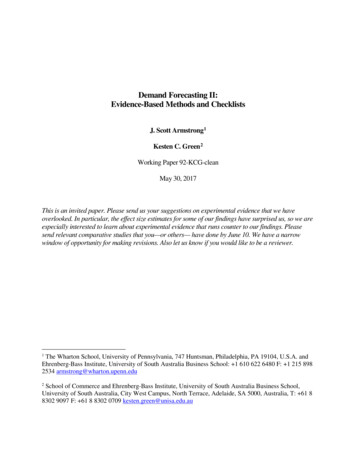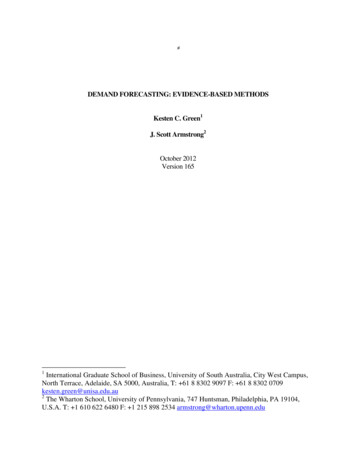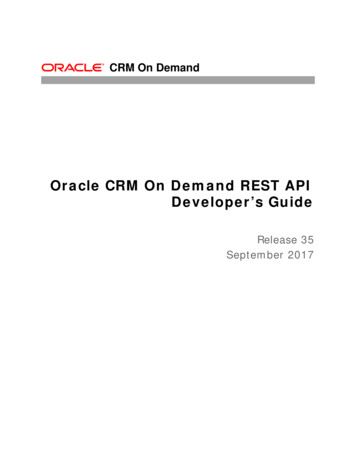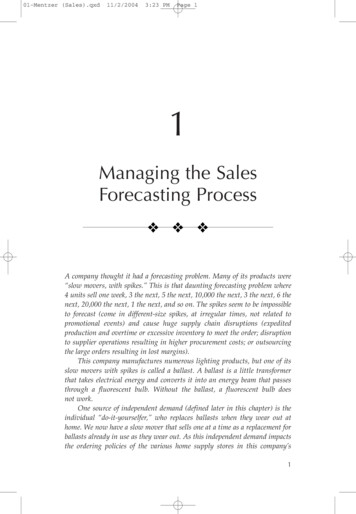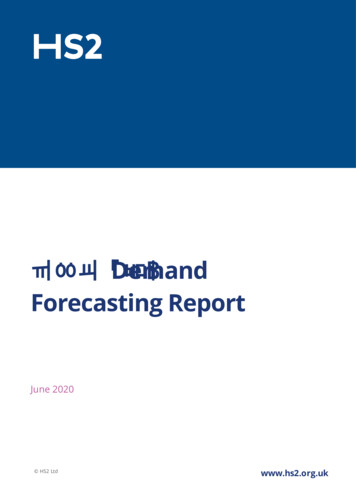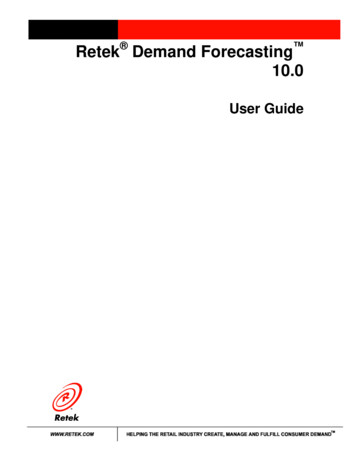
Transcription
Retek Demand Forecasting 10.0User Guide
Retek Demand ForecastingThe software described in this documentation is furnished under a licenseagreement, is the confidential information of Retek Inc., and may be usedonly in accordance with the terms of the agreement.No part of this documentation may be reproduced or transmitted in any formor by any means without the express written permission of Retek Inc., Retekon the Mall, 950 Nicollet Mall, Minneapolis, MN 55403, and the copyrightnotice may not be removed without the consent of Retek Inc.Information in this documentation is subject to change without notice.Corporate Headquarters:Retek provides product documentation in a read-only-format to ensurecontent integrity. Retek Customer Support cannot support documentationthat has been changed without Retek authorization.Retek Inc.Retek on the Mall950 Nicollet MallMinneapolis, MN 55403888.61.RETEK (toll free US) 1 612 587 5000European Headquarters:Retek110 Wigmore StreetRetek Demand Forecasting is a trademark of Retek Inc.Retek and the Retek logo are registered trademarks of Retek Inc.This unpublished work is protected by confidentiality agreement, and bytrade secret, copyright, and other laws. In the event of publication, thefollowing notice shall apply:LondonW1U 3RWUnited KingdomSwitchboard: 2004 Retek Inc. All rights reserved.All other product names mentioned are trademarks or registered trademarksof their respective owners and should be treated as such. 44 (0)20 7563 4600Sales Enquiries: 44 (0)20 7563 46 46Fax: 44 (0)20 7563 46 10Printed in the United States of America.
Customer SupportCustomer Support hoursCustomer Support is available 7x24x365 via e-mail, phone, and Web access.Depending on the Support option chosen by a particular client (Standard, Plus, orPremium), the times that certain services are delivered may be restricted. Severity 1(Critical) issues are addressed on a 7x24 basis and receive continuous attention untilresolved, for all clients on active maintenance. Retek customers on active maintenanceagreements may contact a global Customer Support representative in accordance withcontract terms in one of the following ways.Contact MethodContact InformationE-mailsupport@retek.comInternet (ROCS)rocs.retek.comRetek’s secure client Web site to update and view issuesPhone1 612 587 5800Toll free alternatives are also available in various regions of the world:AustraliaFranceUnited KingdomUnited States1 800 555 923 (AU-Telstra) or 1 800 000 562 (AU-Optus)0800 90 91 660800 917 28631 800 61 RETEK or 800 617 3835MailRetek Customer SupportRetek on the Mall950 Nicollet MallMinneapolis, MN 55403When contacting Customer Support, please provide: Product version and program/module name. Functional and technical description of the problem (include business impact). Detailed step by step instructions to recreate. Exact error message received. Screen shots of each step you take.
Contents iContentsChapter 1 – Retek Demand Forecasting Overview . 1What is Retek Demand Forecasting? . 1Forecasting challenges and solutions . 2Selecting the best forecasting method . 2Handling items with limited demand histories . 2Handling lost sales and unusually high demand. 3Forecasting demand for new products and locations. 3Incorporating the effects of promotions and other event-based challenges on demand. 4Providing detailed sales predictions based on an assortment plan . 4Retek Demand Forecasting Features. 5Automated alert system for user-maintained exception reporting. 5Generation of both final level and source level forecasts. 6Retek Demand Forecasting Modules . 7Predict. 7Promote. 7Curve . 7Preprocessing. 8Chapter 2 – Predict (Statistical Forecasting). 9Overview . 9Workbooks and Wizards . 9Forecasting Methods . 9Forecast Administration Workbook . 12Forecast Administration Wizard. 13Basic Settings workflow tab . 13Advanced Settings workflow tab. 20Forecast Maintenance Workbook. 26Forecast Maintenance Wizard . 26Basic Settings workflow tab . 27Advanced Settings workflow tab. 29Run Batch Forecast . 37Batch Forecast Wizard. 37
ii Retek Demand ForecastingDelete Forecasts . 38Delete Forecasts Wizard. 38Forecast Approval Workbook . 39Forecast Approval Wizard. 40Final Forecast Worksheet . 41Source Level Worksheet. 43Approval Worksheet. 44Final or Source Parameters Worksheet . 45Confidence Worksheet . 47Interactive Forecasting Workbook . 47Forecasting Parameter Worksheet . 49Interactive Forecasting Worksheet . 50Forecast Scorecard Workbook . 51Forecast Scorecard wizard. 52Final Error Measure Worksheet . 53Final Actuals vs. Forecasts Worksheet. 55Export Forecasts. 56Export Forecasts Wizard . 57Forecast Export Administration Workbook . 58Access the Forecast Export Administration Workbook . 58Export Parameters Worksheet . 59Procedures in Statistical Forecasting. 63Set or change default parameters for a forecast. 63Adjust forecast parameters for specific products or locations. 64Manually request an unscheduled forecast . 65Review, modify, and approve forecast values . 66Manually export a forecast to another program. 68Set or change forecast export parameters . 69Monitor the accuracy of Retek Demand Forecasting forecasts . 69Delete an unnecessary forecast. 70Chapter 3 – Promote (Promotional Forecasting) . 71Overview . 71What is Promotional Forecasting?. 71Comparison between promotional and statistical forecasting . 72Developing promotional forecast methods. 72Retek’s approach to promotional forecasting . 74Promotional forecasting terminology and workflow. 74Promote Workbooks and wizards. 75
Contents iiiPromotion Planner Workbook Template. 76Promotion Planner wizard . 77Promotion Planner Workbook and Worksheet . 77Promotion Selector Template. 78Promotion Selector Wizard . 78Causal Maintenance Workbook Template . 79Causal Maintenance Wizard. 79Causal Maintenance Workbook and Worksheets . 80Promotion Analysis and Planning Workbook Template. 82Promotion Analysis and Planning Wizard. 82Promotion Analysis and Planning Workbook . 83Procedures in Promotional Forecasting. 84Set up the system to run a promotional forecast. 84Chapter 4 – Curve (Profile-based Forecasting) . 85Overview . 85Profile Management Terminology and Workflow . 86Profiles (spreading ratios). 86Profile generation techniques . 87Building system profiles based on the historic level . 88Overriding profiles by adjusting the source measure . 88Defining the training window for historical data. 89Aggregating historical data. 89Unreliable data, thresholds, and threshold exceptions. 91Loading default ratios. 92Approving the generated profiles . 92Profile Administration Workbook. 95Profile Administration Wizard . 95Core Profile Worksheet . 96Creating new profile templates. 98Profile Maintenance Workbook . 98Profile Maintenance Wizard. 98Profile Maintenance Workbook. 99
iv Retek Demand ForecastingRun Batch Profile . 100Profile Approval Workbook. 101Profile Approval Wizard . 101Profile Approval Worksheet. 102Source Level Worksheet. 103Final Profile Worksheet. 105Procedures in Profile-based Forecasting . 106Set default parameters for a profile . 106Modify the training window for a subset of items in a profile . 107Manually request a generated profile . 107Approve a profile. 108Set Retek Demand Forecasting to perform plan explosion . 109Create a new profile template. 110Chapter 5 – Preprocessing. 113Overview . 113Preprocessing Workbook templates and wizards. 113Administration Workbook. 114Administration Wizard . 114Administration Worksheet. 114Run Batch Workbook. 116Run Selection Update. 116Preprocessing methods . 118Available preprocessing methods. 118Mathematical formulation of preprocessing methods . 122Chart-form examples of preprocessing effects . 125Chapter 6 – Retek Demand Forecasting methods . 129Forecasting techniques used in RDF . 129Exponential smoothing . 129Regression analysis . 130Bayesian analysis. 130Prediction intervals . 130Automatic method selection . 130Source level forecasting. 131Promotional forecasting. 131
Contents vTime series (statistical) forecasting methods . 131Why use statistical forecasting? . 132Confidence limits. 133Auto Exponential Smoothing (AutoES) forecasting . 133Definitions of equation notation used in this section. 134Components of exponential smoothing . 135Simple moving average . 135Simple exponential smoothing . 136Croston’s method. 137Simple/Intermittent Exponential Smoothing . 138Holt exponential smoothing. 138Multiplicative Winters exponential smoothing . 139Additive Winters exponential smoothing . 140Seasonal Exponential Smoothing (SeasonalES). 141Seasonal Regression . 142Bayesian Information Criterion (BIC). 144Automatic forecast level selection (Auto-Select) . 147Profile-based forecasting. 150Forecast method. 150Profile based method and new SKUs . 151Example. 151Bayesian forecasting . 152Sales plans vs. historic data . 153Forecasting algorithm . 153Guidelines. 155Causal (promotional) forecasting methods . 155The causal forecasting algorithm. 157Causal forecasting algorithm process . 159Causal forecasting array interface description. 161Causal forecasting at the daily level . 161Final considerations about causal forecasting . 163Glossary. 165Index. 173
Chapter 1 – Retek Demand Forecasting Overview 1Chapter 1 – Retek Demand Forecasting OverviewWhat is Retek Demand Forecasting?Retek Demand Forecasting is a Windows-based statistical and causalforecasting solution. It uses state-of-the-art modeling techniques to produce highquality forecasts – with minimal human intervention. Forecasts produced by theDemand Forecasting system enhance the retailer’s supply-chain planning,allocation, and replenishment processes, enabling a profitable and customeroriented approach to predicting and meeting product demand.Today’s progressive retail organizations know that store-level demand drives thesupply chain. The ability to forecast consumer demand productively andaccurately is vital to a retailer’s success. The business requirements forconsumer responsiveness mandate a forecasting system that more accuratelyforecasts at the point of sale, handles difficult demand patterns, forecastspromotions and other causal events, processes large numbers of forecasts, andminimizes the cost of human and computer resources.Forecasting drives the business tasks of planning, replenishment, purchasing, andallocation. As forecasts become more accurate, businesses run more efficientlyby buying the right inventory at the right time. This ultimately lowers inventorylevels, improves safety stock requirements, improves customer service, andincreases the company’s profitability.The competitive nature of business requires that retailers find ways to cut costsand improve profit margins. The accurate forecasting methodologies providedwith Retek Demand Forecasting can provide tremendous benefits to businesses.A connection from Retek Demand Forecasting to Retek Predictive Planningproducts is built directly into the business process by way of the automaticapprovals of forecasts, which are then fed directly to Retek Predictive Planning.This process allows you to accept all or part of a generated sales forecast. Oncethat decision is made, the remaining business measures are planned within RetekTopPlan.
2Retek Demand ForecastingForecasting challenges and solutionsA number of challenges affect the ability of organizations to forecast productdemand accurately. These challenges include selecting the best forecastingmethod to account for level, trending, seasonal, and spiky demand; generatingforecasts for items with limited demand histories; forecasting demand for newproducts and locations; incorporating the effects of promotions and other eventbased challenges on demand; and accommodating the need of operationalsystems to have sales predictions at more detailed levels than planning programsprovide.Selecting the best forecasting methodOne challenge to accurate forecasting is the selection of the best model toaccount for level, trending, seasonal, and spiky demand. Retek’s AutoES(Automatic Exponential Smoothing) forecasting method eliminates thiscomplexity.The AutoES method evaluates multiple forecast models, such as SimpleExponential Smoothing, Holt Exponential Smoothing, Additive andMultiplicative Winters Exponential Smoothing, Crostons Intermittent DemandModel, and Seasonal Regression forecasting to determine the optimal forecastmethod to use for a given set of data. The accuracy of each forecast is evaluated,as is the complexity of the forecast model, in order to determine the mostpredictive method. You simply select the AutoES forecast generation method,and the system finds the best model.Handling items with limited demand historiesAnother challenge to creating accurate forecasts is predicting demand for itemswith a limited sales history. The accuracy of time series forecasts is diminishedwhen short or sparse historical data is fed into the forecasting model. TheDemand Forecasting approach to this challenge is to generate forecasts atmultiple levels of data aggregation.Forecasts are typically difficult to generate directly at the SKU/Store/Week leveldue to the low sales volumes of the items in question. Although forecastinformation is often required at a low level, the final forecast level, data is oftentoo sparse and noisy to identify clear demand patterns. For this reason, it issometimes necessary to aggregate sales data from this base level to a higherforecasting level in order to generate a reasonable forecast. At the higher level,trends and seasonality in the data can be more readily identified. Once theforecast is created at the higher level, the source level, the results can be spreadback down to the final level based on that lower level’s relationship to the total.Demand Forecasting generates forecasts directly at the lower level to determinedemand proportions across SKUs.
Chapter 1 – Retek Demand Forecasting Overview 3Handling lost sales and unusually high demandFuture forecasts should be based on past demand. Unfortunately, retailers cannotrecord demand, but instead record sales. These two figures can differ wheninventory drops to zero and there is demand, but no sales. To deal with thissituation, RDF has a module called Preprocessing that recognizes when salesmight be lower than actual demand, and adjusts sales values up to a level to apredicted level of where demand might have been.Another situation when a retailer might want to adjust sales before using them asproxies for demand in forecasting is when past sales were unusually high due toan external event that is not expected to repeat. For example, if bad weathercauses a power outage, then sales of batteries and flashlights for the week arelikely to soar. These high sales values, however, are not good predictors ofexpected sales for the next week, when a power outage is less likely to occur. Inthis case, one would want to adjust sales downward, not so much to reflect truedemand as to reflect “normal” demand. The same interpolation algorithms usedto adjust sales up to correct for lost sales can be used to adjust sales down tocorrect for unusually high demand.For more details on the Preprocessing module, see Chapter 5.Forecasting demand for new products and locationsRetek Demand Forecasting can also forecast demand for new products andlocations for which no sales history exists. You can model a new product’sdemand behavior based on that of an existing similar product for which you dohave a history. Forecasts can thus be generated for the new product based on thehistory and demand behavior of the existing one. Likewise, the sales histories ofexisting store locations can be used as the forecast foundation for new locationsin the chain. For more details, see the Forecast Maintenance – Advanced Tabsection in Chapter 2.
4Retek Demand ForecastingIncorporating the effects of promotions and other event-basedchallenges on demandPromotions, non-regular holidays, and other causal events create anothersignificant challenge to accurate forecasting. Promotions such as advertised salesand free gifts with purchase can have a significant impact on a product’s saleshistory, as can irregularly occurring holidays such as Easter.Using Promote (an optional add-on to Retek Demand Forecasting) promotionalmodels of forecasting can be developed to take these and other factors intoaccount when forecasts are generated. Promote attempts to identify the causes ofdeviations from the established seasonal profile, quantify these effects, and usethe results to predict future sales when conditions in the selling environment willbe similar. This type of advanced forecasting identifies the behavioralrelationship of the variable you want to forecast (sales) not only to its own past,but also to explanatory variables such as promotion and advertising.Suppose that your company has a large promotional event during the Easterseason each year. The exact date of the Easter holiday varies from year to year;as a result, the standard time series forecasting model often has difficultyrepresenting this effect in the seasonal profile. Promote tool allows you toidentify the Easter season in all years of your sales history, and then define theupcoming Easter date. By doing so, you can causally forecast the Easter-relateddemand pattern shift.Providing detailed sales predictions based on an assortmentplanThe planning process attempts to establish the correct balance between differentproducts in order to maximize sales opportunities within the available sellingspace. To facilitate this process, an assortment plan is often created. Theassortment plan provides details of anticipated sales volumes and stock needs ataggregated levels. However, many operational systems require base data atmuch lower hierarchical levels, because these systems are responsible forensuring that proper quantities of individual products are pre
Demand Forecasting generates forecasts directly at the lower level to determine demand proportions across SKUs. Chapter 1 - Retek Demand Forecasting Overview 3 Handling lost sales and unusually high demand Future forecasts should be based on past demand. Unfortunately, retailers cannot record demand, but instead record sales.

